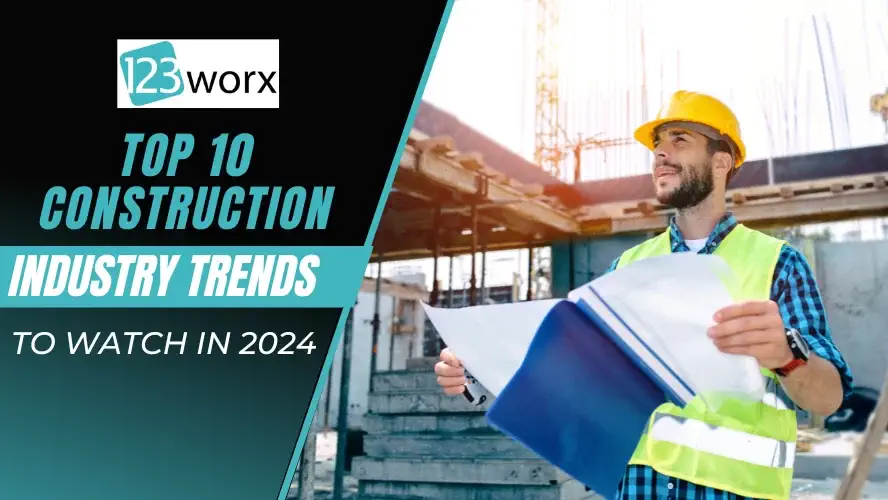With 2024 rounding off, changes, extensive transformation, and great developments are just approaching in the construction industry. The advancement in technology and rising need for sustainability are reshaping the way we build and design these days.
In this article, we will look at the top 10 emerging trends that will help shape the future of the construction sector in the USA and Canada in 2024. Staying updated with these key trends allows construction professionals to gain adaptability and excel in an evolving industry.
The Importance of Staying Updated with Construction Industry Trends
In the evolving construction industry, staying updated with emerging trends is crucial.
The construction landscape is dynamic in nature and those who fail to adapt can fall behind. From one generation to the next, professionals who are current can always preempt events, stay alert, and have an upper hand with contracting opportunities that are being created.
This also ensures that industry players are acquainted with future trends so that they can adopt and provide innovative solutions to their clients that guarantee their reputation and competitiveness in the market. There are various factors responsible for shaping the construction industry and for that staying informed is essential to simplify risky tasks and stay ahead of your competition.
Trend 1: Sustainability and green building practices
One of the major patterns seen in the construction industry is the increasing focus on sustainable and green building. Scenarios prevalent in the world point toward a changing climate phase and dwindling resources in multiple sectors, whereas the construction sector has to act very effectively to minimize its environmental impact.
Concentration in 2024 seems to happen on similar activities, where the efficiency of energy is maximized with sustainable materials or integration of the innovative uses of renewable energy in construction projects.
This can be an industry commitment to sustainability with green certifications such as LEED—Leadership in Energy and Environmental Design—or other B Corp certifications such as a benefit corporation.
Trend 2: Increased adoption of technology and automation
Technology continues to revolutionize the diverse construction industry. Building Information Modeling (BIM) through an advanced project management software package are just a few examples of how technology is being used by many construction industry professionals to ease processes and increase collaboration and productivity.
The next years are more likely to face an increase in the frequency of automated applications, robotics, and artificial intelligence technologies in construction. These applications will allow for the speeding of the execution of the construction processes and also will increase accuracy and safety, preventing a series of accidents.
Trend 3: Modular and prefabricated construction methods
Modular and prefabricated construction methods are being acclaimed for numerous benefits. This modern adoption trend in 2024 will rise as the strategy impacts increased timelines for constructing buildings, less waste from culling mistakes or inefficiencies, and attempts at quality control.
For that reason, modular construction is about the development of such construction elements someplace away from the land for finally raising them on a site. Better levels of accuracy will be attained, and the technique makes it a desirable modular option for the construction of varied types.
Trend 4: Use of drones and robotics in construction
Drones and Robotics empower new capabilities and efficiencies in the construction industry. As we move into 2024, these technologies will become even more prevalent daily and reinvent the way of conducting surveys, inspections, and monitoring of the site.
Drones equipped with cameras and sensors gather data accurately enabling better decision-making and reducing the time and resources compared to conventional survey methods.
At the same time, robotics can automate repetitive actions, like bricklaying and pouring concrete on construction sites, emphasizing the ability to increase the safety levels and productivity of employees.
Trend 5: Virtual reality and augmented reality in construction design
Virtual and augmented reality (VR and AR) are on the edge of revolutionizing construction designs in 2024. The technologies will enable architects, engineers, and clients to preview the designs and experience before the construction begins.
VR allows users to completely immerse themselves in a virtual environment, while AR overlays virtual elements over the real world. These cutting-edge technologies will help construction professionals to identify design flaws, make informed decisions, and communicate such decisions to the stakeholders. This enhanced visualization and collaboration will drive greater efficiency and success in construction projects.
Trend 6: Growth of the smart construction market
The smart construction market is growing propelled by the expansion of the Internet of Things (IoT) and the integration of smart technologies. Higher construction ventures will be using more IoT devices and sensors to monitor and optimize building performance.
Smart buildings will be equipped with interconnected systems that enable efficient energy management, predictive maintenance, and enhanced occupant comfort. This opens up enormous opportunities for professionals to adopt cutting-edge technologies and deliver intelligent and sustainable infrastructure solutions.
Trend 7: Focus on safety and worker well-being
Worker well-being and safety are essentials in the construction industry but as we move into 2024, they will acquire the center stage.
It is becoming evident that if more emphasis were put on workplace safety and the mental care of laborers, then construction companies would prioritize creating safe and supportive environments for their employees.
This involves strict safety measures, training, education, and even mental health materials. This will help the construction sector in gaining skilled workers in good numbers that can help it build a positive image altogether.
Trend 8: Shift towards renewable energy sources in construction
As the world shifts towards a sustainable future, the construction sector will assume a crucial role in adopting renewable energies.
The new buildings and refurbishments will integrate more solar panels, wind turbines, and other forms of renewable sources as part of the replacement of conventional materials.
Buildings will be designed to generate and store their energy, reducing the amount taken off the conventional power grid, and minimizing carbon footprints. With this switch to renewable resources for energy comes not just a green world but long-term costs saved for the building owner.
Trend 9: Rise of urbanization and infrastructure development
The future will be characterized by global urbanization. In 2024, there will be a thrust into the construction of sophisticated urban infrastructures in invention that can accommodate the fast-growing urban population. This will emerge quite a high demand for some of the constructions ranging from the tallest buildings to the transportation infrastructure that will be needed to serve the population of the expanded urban area.
Consequently, there will be a heightened need to train professionals in the sector, whereby they are initiated on the skills of urban planning, sustainable infrastructure, and transportation systems so that they can tap the opportunities that come with urbanization.
Trend 10: Integration of artificial intelligence in construction processes
The wave of artificial intelligence has taken over almost all industries; no exception exists in the construction sector.
In such cases, AI should be well-integrated into many construction processes, from project management, and risk assessment to proper quality control.
Large amounts of data need to be examined by the Artificial Intelligence algorithm in the construction regarding cost overruns within the project and optimizing the entire workflow of construction. Through the power of AI, construction workers can derive facts from the data, lower errors, and improve the project.
Embracing the future of the construction industry
In 2024, sustainability, technology, and innovation will forge ahead to define the construction industry. Taking these trends at hand is going to provide a roadmap for professionals on how to navigate the challenges in realizing and capitalizing on the opportunities that lie ahead.
Practices to sustain the ever-growing construction sector and individual technologies are slowly taking over and becoming the spotlight of the future for the entire construction industry.
Construction professionals must align themselves to what is at the cutting edge, adapt to the new environment, and drive further improvement of the built environment.
Follow to keep up to date with new insights on how to follow trends and prepare to be part of the future construction industry.
Get in touch with 123worx for guidance on managing your projects most cost-effectively. Request a demo today and get a tailored solution to your needs.

As a Vice President at 123worx, Construction Management Platform, Bharat Rudra has worked with hundreds of business executives searching for best-suited software for their construction business with a wide array of requirements. Bharat takes pride in helping construction businesses solve their business and project management challenges. Feel free to reach Bharat if you have any questions. You can find him on LinkedIn or reach him at brudra@123worx.com

